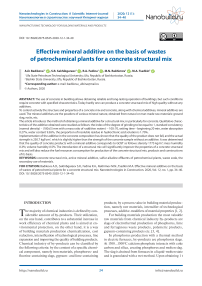Effective mineral additive on the basis of wastes of petrochemical plants for a concrete structural mix
Автор: Badikova A.D., Sakhibgareev S.R., Fedina R.A., Rakhimov M.N., Tsadkin M.A.
Журнал: Nanotechnologies in Construction: A Scientific Internet-Journal @nanobuild-en
Рубрика: Manufacturing technology for building materials and products
Статья в выпуске: 1 Vol.12, 2020 года.
Бесплатный доступ
The use of concrete in building allows obtaining reliable and long-lasting operation of buildings, but such conditions require concrete with specified characteristics. Today hardly one can produce a concrete structural mix of high quality without any additives. To control actively the structure and properties of a concrete mix and concrete, along with chemical additives, mineral additives are used. The mineral additives are the powders of various mineral nature, obtained from natural or man-made raw materials: ground slag, rocks, etc. The article introduces the method of obtaining a mineral additive for a structural mix, in particularly for concrete. Qualitative characteristics of the additive obtained were studied as follows: the index of the degree of grinding to be equal to 1, standard consistency (normal density) – (180±5) mm with a mass ratio of «additive: water») – 100: 70, setting time – beginning 20 min, water absorption 0.27%, water content 9.65%, the proportion of insoluble residue in hydrochloric acid solution is 1.70%. Implementation of the additive in the concrete composition has shown that the quality of the product does not fall, and the actual strength is 250.7 kgf/cm2, which is slightly higher than the strength of the concrete sample without an additive. It was determined that the quality of concrete products with a mineral additive corresponds to GOST as follows: density 1775 kg/m3; mass humidity 0.3%; volume humidity 0.5%. The introduction of a structural mix will significantly improve the properties of a concrete structural mix and will also reduce the fuel resources consumption for production of the concrete structural mix, products and constructions of its basis.
Concrete structural mix, active mineral additive, sulfur-alkaline effluents of petrochemical plants, waste soda, the secondary use of materials
Короткий адрес: https://sciup.org/142227434
IDR: 142227434 | DOI: 10.15828/2075-8545-2020-12-1-34-40
Список литературы Effective mineral additive on the basis of wastes of petrochemical plants for a concrete structural mix
- Popov L.N. Building materials from industrial wastes. Moscow, Knowledge, 1978. pp. 55.
- Dvorkin L.I. Building materials from industrial waste. K.: Stroyizdat, 1998. pp. 38–42.
- Smooth K. Slags are not waste, but valuable raw materials. L.: Chemistry, Leningrad. Dep., 1989. pp. 55–57.
- Schukina E.G., Bepple R.R. The integrated use of mineral raw materials and industrial waste for the production of building materials. Moscow, Chemistry, 2004. pp. 10–16, 20–49, 51–68, 105–116.
- Bazhenov P.I. The use of industrial waste for the production of building materials. L.: Stroyizdat, Leningrad. Dep., 1989. pp. 12–15.
- Vihter Ya.I. Production of lime-belite binders. Moscow, Higher School, 1974. pp. 13–15.
- Rybev I.A. Cement-based building materials. Moscow, Chemistry, 1978. pp. 76–83.
- Pat. 2297989 Russia, IPC C04B 11/05. A method of obtaining active anhydrite / Zykov V.M., Zykova N.S., Fedorchuk Yu.M., Tsygankova T.S. – No. 2005132129/03; declared 10/17/2005; publ. 04/27/2007. p. 3
- Pat. 2081074 Russia, IPC C04B 7/00. The method of preparation of the raw mix to obtain cement clinker. Afanasev V.V., Kolesnikov V.Ya., Mukhanov A.A., Sukhanov M.A., Fedner L.A., Khrapov V.S., Yusupov I.G.; declared 02/13/1995; publ. 06/10/1997. p. 2.
- Pat. 95102840 Russia, C09K8/80. Compounds for strengthening proppant ruptures used to maintain open ruptures. Plotnikov V.A., Peychev V.G., Pribytkov E.A., Alekseev V.V.; declared 05/06/2011; publ. 10/10/2012. p. 3.
- Pat. 2200714 Russia, C04B11/26. A method of obtaining a binder. Suchkov V.P., Kiushkin E.V.; declared 04/23/2001; publ. 03/20/2003. p. 2.
- Smirnov D.N., Dmitriev A.S. Automatic dosing of reagents during effluent treatment and water treatment. Moscow, Chemistry, 1956. pp. 174–180.
- Krause L.S. Preparation of solutions and concrete mixes. Moscow, Stroyizdat, 1968 . pp. 22–25.
- Lanina T.D. Comprehensive utilization of oil and gas industrial wastes to ensure environmental safety and additional extraction of mineral raw materials. Abstract of Doctorate thesis in Engineering. Ukhta, 2009. p. 34.
- Egorova G.I. Waste management as a social problem of improving the quality of human life. Materials of the International scientific and practical conference. Responsible author E.I. Brazhnik. –SPb.: Express, 2012. pp. 46–50.
- Sigitova I.S. Evaluation of the effectiveness and classification of mineral additives to cements. Basic research. 2015. No. 11. pp. 1109–1113.
- Lipunova I.N., Yupatov A.A., Alikin V.I. The use of solid industrial waste in the production of building materials. Ecology and Industry of Russia. 2009. № 3. pp. 19–23.
- GOST 22690-2015. Concrete. Determination of strength by mechanical methods of non-destructive testing. –Introduction 04/01/2016. Moscow, Standartinform, 2016. p. 20.
- Ivchatov A.L., Glyadenov S.N. The use of phosphorus production waste as a mineral additive in building materials. Ecology and Industry of Russia. 2007. No. 9. pp. 10–14.
- Murtazaev S.-A.Yu., Batayev Dena K.-S., Ismailova Z.Kh. Fine-grained concrete based on fillers from recycled materials: scientific publication. Moscow, Komtekhprint, 2017. p. 142.
- Batrakov V.G. Concrete modifiers: new opportunities and prospects. Building materials. 2006. No. 10. pp. 4–7.
- Murtazaev S.-A.Yu, Batayev Dena K.-S., Saydumov Magomed S. Cement concrete composites on the basis of bypassed stone and stone milling wastes. Acta Technica CSAV (Ceskoslovensk Akademie Ved) 61, 2016 . No. 4B / 2016. pp. 327–336.
- Usherov-Marshak A.V., Babaevskaya T.V. The effectiveness of additives – the topic of concrete science and concrete technology. Technologies of concrete. 2012. No. 7–8 (72–73). pp. 53–55.


